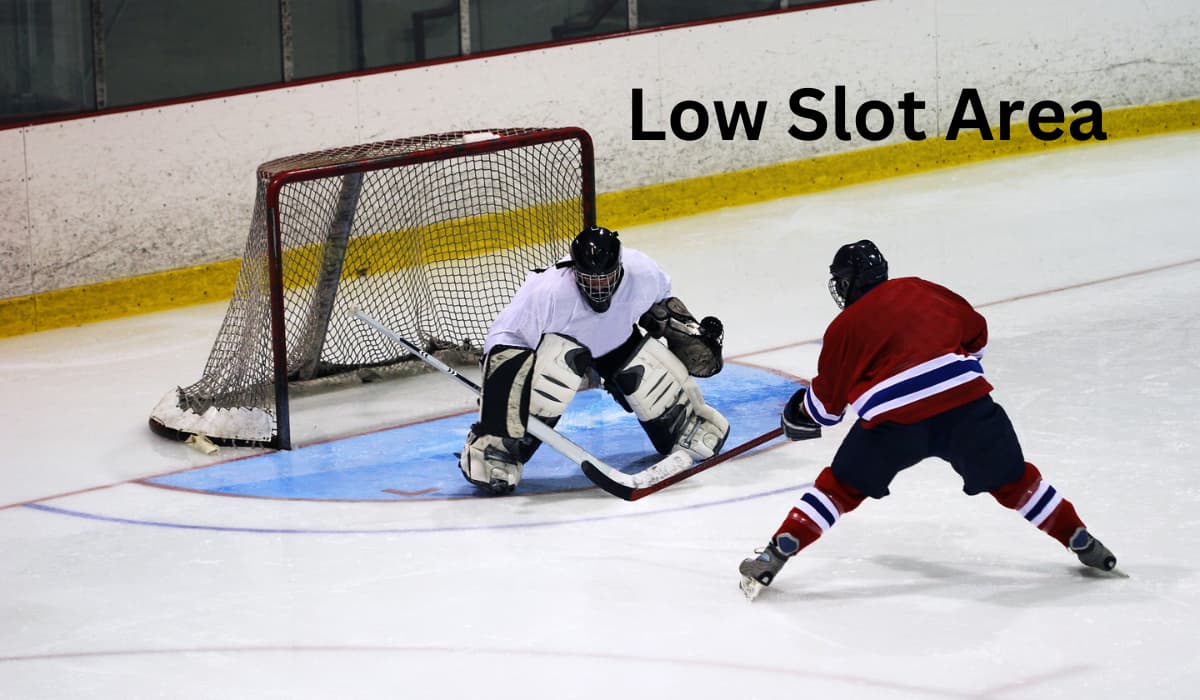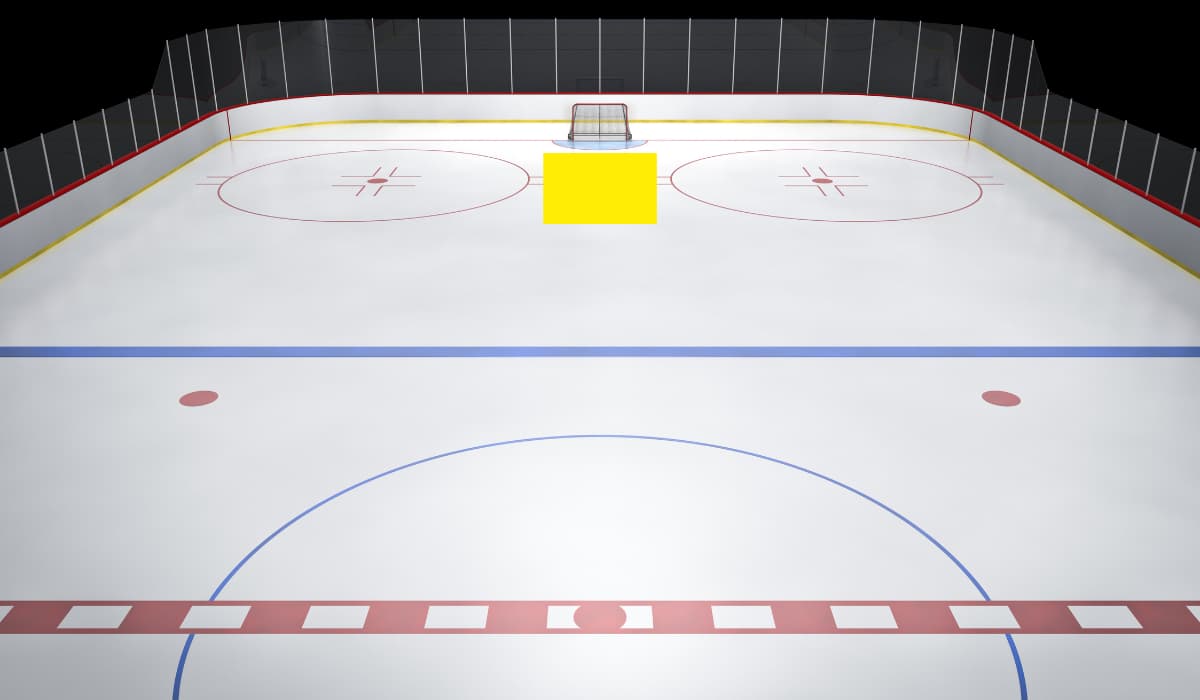What is the Slot in Hockey: A Comprehensive Guide for Parent
In the sport of ice hockey, the term “slot” refers to a specific zone on the rink located directly before the goaltender and between the faceoff circles, reaching up to their upper edges. This region is often called the “scoring area” due to its strategic importance in the game.
Regarding the Hockey Slot: The “high” slot covers the region stretching from the topmost parts of the faceoff circles down to the hash marks. In contrast, the “low” slot encompasses the area from the goal crease up to the hash marks.
In this comprehensive guide, I will explain what the slot is, and its role in ice hockey, and provide insights into offensive strategies and player evaluation. So let’s dive in and discover everything you need to know about the hockey slot, positioning, and the scoring area!
What is the Slot in Hockey
Key Takeaways:
- The slot is a high-danger scoring area located between the two faceoff circles in the offensive zone.
- Offensive players position themselves in the slot to create scoring opportunities through receiving passes, taking shots, and screening the goaltender.
- The slot is different from the crease, where offensive players are not allowed to interfere with the goaltender.
- Scoring from the slot requires specific techniques, including finding open space, quick-release shots, and accurate passing skills.
- Coaches often implement offensive strategies that focus on utilizing the slot as a focal point for scoring opportunities.
The Role of the Slot in Ice Hockey
In ice hockey, the slot plays a crucial role in offensive strategies and scoring goals. Positioned in the offensive zone, the slot is an area where players aim to position themselves to create scoring opportunities. It is a high-traffic zone where players can receive passes, take shots, and screen the opposing goaltender. To effectively play in the slot, players require good puck-handling skills and Hockey sense.
Coaches emphasize the importance of establishing a strong presence in the slot to increase the chances of scoring goals. By positioning themselves strategically in this area, players become a threat to the opposing team’s defense and have a better chance at converting scoring opportunities. The slot is often referred to as a high-danger scoring area due to the numerous opportunities it presents.
Players in the slot need to be quick and agile, as the area can become crowded and chaotic. They must have the ability to read the play, anticipate scoring chances, and make split-second decisions. Additionally, players in the slot must be able to make accurate passes, have a quick release on their shots, and possess a strong net-front presence to capitalize on rebounds and deflections.
Advantages of Playing in the Slot
Playing in the slot offers several advantages for offensive players. First and foremost, it provides players with a prime position to receive passes from teammates and unleash quick shots on goal. It puts players in the heart of the action, giving them the best opportunity to score goals.
Furthermore, being in the slot allows players to create havoc in front of the opposing goaltender. By screening the goalie’s view and disrupting their positioning, players can increase the chances of scoring goals or causing rebounds that their teammates can capitalize on.
Another advantage of playing in the slot is the ability to exploit defensive gaps. The crowded nature of this area often creates confusion and breakdowns in the opposing team’s defense. Skilled players can find seams or open spaces in the slot, allowing them to receive passes and take shots without much interference.
Hockey Slot vs. Crease: Knowing the Difference
When it comes to ice hockey, it’s important to understand the distinction between the hockey slot and the crease. The slot refers to the area in the offensive zone, located between the two faceoff circles, where offensive players position themselves to create scoring opportunities. On the other hand, the crease is the marked area in front of the goaltender’s net, where the goaltender has exclusive rights to defend their goal.
In the slot, offensive players have the freedom to enter and position themselves to receive passes, take shots, and screen the opposing goaltender. They play a crucial role in creating offensive plays and increasing the chances of scoring goals. However, it’s important to note that players must avoid interfering with the goaltender in the crease. The crease is a protected area where the goaltender needs space to make saves and defend their goal effectively.

Knowing the difference between the hockey slot and the crease is essential for fair play and avoiding penalties. Offensive players should focus on establishing their presence in the slot to maximize their scoring potential while respecting the goaltender’s rights in the crease. By understanding these distinctions, players can contribute to a more cohesive and competitive game.
Hockey Slot vs. Crease: Knowing the Difference
| Area | Description |
|---|---|
| Hockey Slot | The area in the offensive zone between the two faceoff circles where offensive players position themselves for scoring opportunities. |
| Hockey Crease | The marked area in front of the goaltender’s net, where the goaltender has exclusive rights to defend their goal. |
Scoring from the Slot: Techniques and Tactics
The slot is a critical hockey scoring area where players position themselves strategically to create high-quality scoring opportunities. To effectively score from the slot, players need to employ specific techniques and tactics that capitalize on defensive gaps and create open space. This section explores some key strategies for scoring goals from the slot in ice hockey.
Techniques for Scoring from the Slot
When it comes to scoring from the slot, players should focus on honing certain skills and techniques. First and foremost, players need to have a quick release with their shots. The ability to get off a shot quickly and accurately increases the chances of beating the goaltender. Players should also work on their puck-handling skills to maintain control in tight spaces and navigate through congestion in the slot. Accuracy in passing is crucial for setting up scoring opportunities for both themselves and their teammates.
Another important technique is reading the play and anticipating scoring chances. This requires players to have a strong understanding of the game and the ability to position themselves effectively in the slot. By recognizing defensive gaps and finding open spaces, players can position themselves for high-quality scoring chances.
Tactics for Scoring from the Slot
Effective offensive tactics play a significant role in scoring from the slot. Coaches often teach players to utilize the slot as a focal point for their offensive strategies. This can involve cycling the puck to create open passing lanes into the slot, causing confusion among defenders and increasing the chances of finding scoring opportunities.

Crashing the net is another common tactic for scoring from the slot. By creating traffic in front of the goaltender, players can disrupt their line of sight and increase the likelihood of scoring on rebounds or deflections. Working in tandem with teammates to create screens and capitalize on loose pucks in the slot can significantly enhance the effectiveness of offensive tactics.
| Techniques | Tactics |
|---|---|
| Quick release | Cycling the puck |
| Puck-handling skills | Crashing the net |
| Passing accuracy | Creating screens |
| Reading the play | Capitalizing on rebounds and deflections |
Creating scoring opportunities from the slot requires a combination of individual skills, team tactics, and a deep understanding of the game. By mastering the techniques and tactics outlined in this section, players can enhance their ability to score goals from this high-danger area on the ice.
Offensive Strategies
When it comes to ice hockey, offensive strategies play a pivotal role in creating scoring opportunities. Coaches often implement various tactics to maximize their team’s offensive potential, and one key aspect of these strategies is utilizing the slot effectively. The slot, also known as the high-danger scoring area, is a prime location for players to position themselves and capitalize on scoring chances.
One common offensive strategy involves set plays and system designs that emphasize cycling the puck to create open passing lanes into the slot. By moving the puck quickly and efficiently, teams can create confusion among defenders and open up scoring opportunities for players in the slot. This strategy requires careful coordination and strong communication among team members.

In addition to cycling the puck, coaches often encourage players to crash the net and create traffic in front of the goaltender. By doing so, offensive players can disrupt the goalie’s vision and increase the chances of capitalizing on rebounds and deflections. This tactic requires players to be fearless and willing to battle for space in the slot, as well as to have a strong understanding of positioning and timing.
The Importance of Communication and Teamwork
Effective offensive strategies rely heavily on communication and teamwork. Players need to communicate their intentions, signal for passes, and provide support for their teammates in the offensive zone. By working together, teams can create scoring opportunities in the slot and maintain sustained pressure on the opposing defense.
Furthermore, offensive success often hinges on players’ ability to read the play and make split-second decisions. Understanding when to drive to the slot, when to position oneself for a potential pass, and when to release a shot can greatly impact a team’s offensive output. Coaches emphasize the importance of reading the game and making smart decisions to optimize scoring chances from the slot.
In conclusion, offensive strategies in ice hockey revolve around utilizing the slot as a focal point for scoring opportunities. By implementing set plays, creating traffic in front of the net, and emphasizing communication and teamwork, teams can increase their chances of finding the back of the net. Understanding the importance of offensive tactics and the role of the slot is essential for players looking to excel in the offensive zone.
Player Evaluation and Selection
Player evaluation and selection play a crucial role in minor hockey associations. It is essential to assess players’ skills, including their ability to perform in the slot, in order to determine team placements. To ensure fair and transparent selection processes, associations use a variety of evaluation tools and resources. Clear communication, objective evaluations, and a feedback mechanism are essential components of successful player evaluation and placement.
During evaluations, players are assessed based on their overall hockey skills, including their understanding of positioning and scoring opportunities in the slot. Evaluators often use specific scoring rubrics and cue cards to objectively evaluate players according to predetermined criteria. These criteria help ensure fairness and consistency throughout the evaluation process, providing all players with an equal opportunity to showcase their abilities.
Transparency is a key factor in building a positive experience for all involved in minor hockey associations. By providing clear communication and open lines of dialogue, associations can establish a supportive environment for parents and players. Transparent evaluation criteria and processes help parents and players understand how evaluations are conducted and how players are assessed in the slot. This transparency promotes trust and confidence in the evaluation process and contributes to a fair and inclusive experience for everyone.
Evaluation Criteria for Player Selection
| Criteria | Description |
|---|---|
| Skating | Evaluates players’ speed, agility, and overall skating technique. |
| Stickhandling | Assesses players’ ability to handle the puck, maintain control, and make accurate passes. |
| Shooting | Evaluates players’ shooting accuracy, power, and ability to release the puck quickly. |
| Hockey IQ | Assesses players’ understanding of the game, including positional awareness and decision-making. |
| Physicality | Evaluates players’ physical presence, including their ability to win battles and protect the puck. |
| Work Ethic | Assesses players’ commitment, attitude, and willingness to constantly improve their skills. |
These evaluation criteria provide a comprehensive and balanced assessment of players’ skills and abilities, including their performance in the slot. By evaluating players based on these criteria, associations can select teams that are both competitive and inclusive, offering players the opportunity to develop and thrive in the sport of hockey.
Hockey Player Selection Criteria
When it comes to selecting players for a hockey team, there are specific criteria that evaluators consider. These criteria are designed to assess a player’s overall skills and abilities, including their proficiency in the slot. By evaluating players based on predetermined criteria, associations can ensure fairness and consistency throughout the selection process.
Player selection criteria typically include factors such as skating ability, puck handling skills, shooting accuracy, defensive play, and hockey sense. These criteria help evaluators gauge a player’s overall hockey skills and determine their suitability for a particular team or level of play. The ability to effectively play in the slot is often a crucial component of the assessment process.
Associations use various methods to evaluate players, such as scoring rubrics and cue cards. These tools provide evaluators with a structured approach to assess players in different skill areas, including their performance in the slot. By using specific criteria and objective evaluation measures, associations can ensure that the selection process remains fair and transparent.
Player Selection Criteria:
| Criteria | Description |
|---|---|
| Skating Ability | Evaluates a player’s speed, agility, and balance on the ice. |
| Puck Handling Skills | Assesses a player’s ability to control the puck and make effective stickhandling moves. |
| Shooting Accuracy | Evaluates a player’s ability to shoot the puck on target and score goals. |
| Defensive Play | Assesses a player’s ability to play a responsible defensive game, including positioning and stick handling and checking. |
| Hockey Sense | Evaluates a player’s understanding of the game, decision-making skills, and ability to anticipate plays. |
While these criteria provide a framework for player evaluation, it’s important to note that not all players will excel in every area. Evaluators consider a player’s potential for growth, coachability, and their ability to contribute to the team dynamic. By using a comprehensive selection process that includes the assessment of skills, associations can identify players who have the potential to thrive in the slot and make significant contributions to their teams.
Role of Evaluations for Player Development
Evaluations play a crucial role in the development of hockey players. Through the evaluation process, coaches and associations can identify players’ strengths and weaknesses, including their performance in the slot. This valuable feedback helps coaches tailor individualized training plans to address areas that need improvement, such as positioning in the slot. By focusing on these specific areas, players can enhance their skills and progress in their hockey journey.
The evaluation process also serves as a tool for tracking player growth over time. By conducting evaluations at regular intervals, coaches can monitor players’ development and make necessary adjustments to their training plans. This ensures that the players receive the support and guidance they need to reach their full potential.
In addition to individual player development, evaluations also contribute to team building and strategic planning. Coaches can use the evaluation results to form balanced teams, considering players’ abilities to play effectively in the slot. This allows for fair competition and maximizes the team’s chances of success.
Overall, evaluations have a significant impact on player development in hockey. They provide valuable feedback, support individualized training, track growth, and aid in team selection. By embracing the evaluation process, players, coaches, and associations can work together to foster skill development, enhance performance, and create a positive hockey experience.
| Evaluations Benefits: | Evaluations Process: |
|---|---|
| Identify players’ strengths and weaknesses Target areas for improvement Track player growth Individualize training plans Aid in team selection | Clear evaluation criteria Objective assessment methods Regular evaluation intervals Feedback and communication |
Importance of Transparent Evaluation Process
In minor hockey associations, a transparent evaluation process is essential for creating a positive experience for all involved. Clear communication, open lines of dialogue, and transparent evaluation criteria contribute to a fair and inclusive process that benefits players, parents, and coaches alike.
Transparency starts with providing parents and players with a clear understanding of how evaluations are conducted. Openly sharing the evaluation criteria and methods ensures that everyone knows what to expect and how players will be assessed, including their performance in the slot. This knowledge allows parents and players to better understand the strengths of the evaluation process and its importance in fostering player development.
Transparent evaluations also create a supportive environment where parents can actively engage in their child’s hockey journey. By knowing how players are being evaluated, parents can offer support and guidance that aligns with the criteria being assessed. This involvement helps players focus on the areas that need improvement, such as positioning in the slot and encourages their growth and progress.
Moreover, a transparent evaluation process builds trust and confidence within the minor hockey association. When parents and players feel that evaluations are conducted fairly and objectively, they are more likely to have faith in the decision-making process for team placements. This trust strengthens the association’s reputation and fosters a sense of community among its members, ultimately benefiting the sport as a whole.
The Benefits of a Transparent Evaluation Process
- Enhances fairness by providing clear evaluation criteria
- Encourages parental involvement and support
- Fosters trust and confidence within the association
- Promotes a positive and inclusive hockey environment
“Transparent evaluations allow parents and players to fully understand the assessment process and actively participate in their child’s hockey development.”
Table: Evaluating Players in the Slot
| Criteria | Description |
|---|---|
| Positioning | Evaluates the player’s ability to find open space in the slot and maintain a good offensive position. |
| Puck Handling | Assesses the player’s ability to receive passes in the slot, control the puck, and make quick decisions. |
| Shooting | Examines the player’s shooting skills, including accuracy, power, and the ability to release the puck quickly. |
| Net Presence | Considers the player’s ability to screen the goaltender, create traffic in front of the net, and capitalize on rebounds. |
| Hockey Sense | Looks at the player’s understanding of the game, anticipation of scoring opportunities, and ability to read the play. |
Conclusion
Understanding the slot in hockey is essential for parents like me who want to support their children’s development in the sport. The slot, also known as the high-danger scoring area, is where offensive players position themselves to create scoring opportunities. It is a key area on the ice where players can receive passes, take shots, and screen the opposing goaltender. By understanding the role of the slot, we can better appreciate its importance in offensive strategies and help our children excel in this critical area of the game.
Coaches often emphasize the significance of the slot in their offensive tactics. They encourage players to find open space in the slot, exploit defensive gaps, and position themselves for high-quality scoring chances. By developing skills like quick-release shooting, accurate passing, and situational awareness, our children can effectively play in the slot and increase their chances of scoring goals.
Participating in transparent evaluation processes is also crucial for our children’s progress in hockey. Evaluations help identify their strengths and weaknesses, including their performance in the slot. By closely following evaluations and working with coaches on targeted training plans, we can support our children in enhancing their skills, especially in areas like positioning in the slot. Together, we can create a positive and supportive environment that fosters their growth and success in the sport.
FAQ
What is the slot in ice hockey?
The slot is a key area on the ice hockey rink, located between the two faceoff circles in the offensive zone. It is also known as the high-danger scoring area, where players have the best opportunity to score goals.
What is the role of the slot in ice hockey?
The slot is where offensive players position themselves to create scoring opportunities. It is a high-traffic area, where players can receive passes, take shots, and screen the opposing goaltender.
What is the difference between the hockey slot and the crease?
The slot refers to the area in the offensive zone, while the crease is the marked area in front of the goaltender’s net. Offensive players are allowed to enter the slot and position themselves, but they should not interfere with the goaltender in the crease.
What techniques and tactics are involved in scoring from the slot?
Players should aim to find open space in the slot, exploit defensive gaps, and position themselves for high-quality scoring opportunities. They need to have a quick release with their shots, accurate passing skills, and the ability to read the play to anticipate scoring chances.
How do offensive strategies utilize the slot?
Coaches may implement set plays and systems that involve players cycling the puck to create open passing lanes into the slot. They may also encourage players to crash the net and create traffic in front of the goaltender to capitalize on rebounds and deflections.
How are players evaluated and selected in hockey?
Evaluators assess players’ skills, including their ability to play in the slot, to determine team placements. Associations use various evaluation tools and resources to ensure fair and transparent selection processes.
What criteria are used for player selection?
Associations establish player selection criteria to guide the evaluation process. These criteria assess players’ overall hockey skills, including their ability to play in the slot. Evaluators use specific scoring rubrics and cue cards to objectively assess players based on predetermined criteria.
How do evaluations contribute to player development?
Evaluations help identify players’ strengths and weaknesses, including their performance in the slot. The feedback received from evaluations guides coaches in developing individualized training plans for players.
Why is a transparent evaluation process important?
A transparent evaluation process contributes to a fair and inclusive experience for all involved. By providing parents and players with a clear understanding of how evaluations are conducted and how players are assessed in the slot, associations can promote transparency and create a supportive environment.
How can parents support their children’s development in hockey?
Understanding the role of the slot and participating in transparent evaluation processes can help parents support their children’s development in hockey. By being knowledgeable about the game and providing a supportive environment, parents can help their children thrive in the sport.
Source Links
- https://cdn.hockeycanada.ca/hockey-canada/Hockey-Programs/MHA/downloads/mha-player-evaluation-guide-e.pdf
- https://www.achahockey.org/wp-content/uploads/sites/2/2021/07/ACHA_Manual-2020-21-Revised-7_22_20_OFFICIAL.pdf
- https://www.weld.gov/files/sharedassets/public/departments/human-services/documents/parents-guide-to-child-support.pdf



